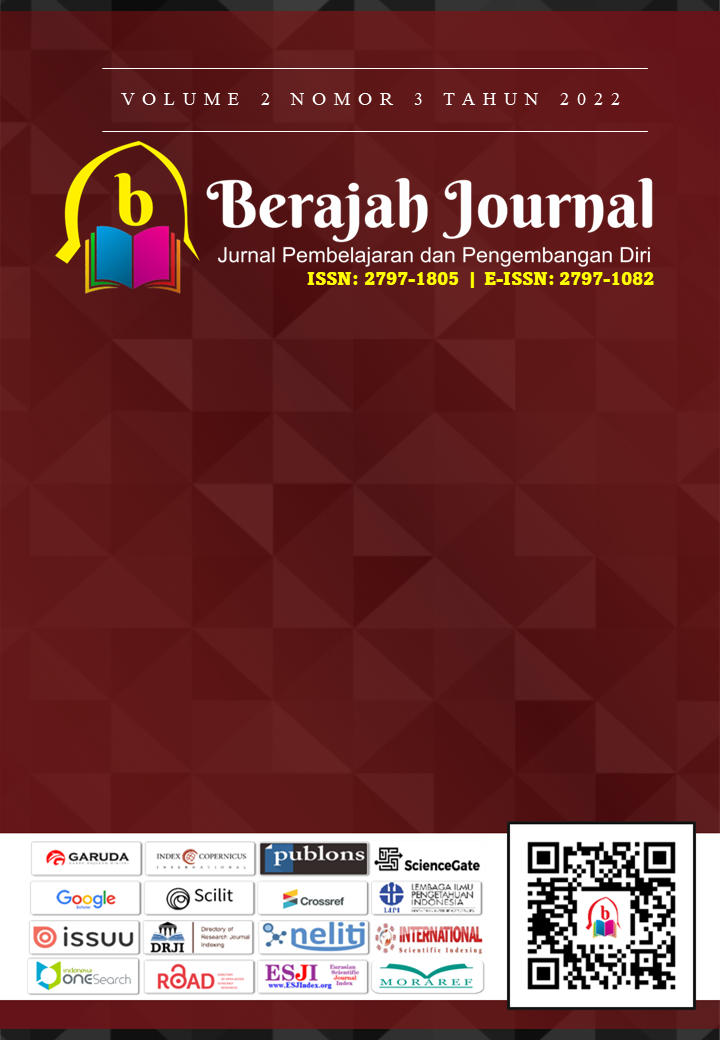KAJIAN PENERIMAAN PENGGUNA E-LEARNING (STUDY KASUS: E-LEARNING STIKES BAITURRAHIM JAMBI)
DOI:
https://doi.org/10.47353/bj.v2i3.151Keywords:
e-Learning, UTAUT2, pendidikan kesehatanAbstract
e-Learning telah menjadi media penyampaian utama bagi institusi pendidikan selama pandemi COVID-19. Dalam studi ini, Unified Theory of Acceptance and Use of Technology (UTAUT2) digunakan untuk menentukan faktor-faktor yang mempengaruhi penerimaan platform e-Learning untuk pendidikan bidang kesehatan di Sekolah Tinggi Ilmu Kesehatan (STIKES) Baiturrahim Jambi selama pandemi COVID-19. Sebanyak 237 mahasiswa berpartisipasi dan menjawab kuesioner yang terdiri dari 36 pertanyaan. Hasil pengolahan data kuisioner menunjukkan bahwa kondisi yang memfasilitasi ditemukan memiliki efek tertinggi pada niat perilaku, yang diikuti oleh motivasi hedonik dan pengaruh sosial. Niat perilaku yang tinggi ditemukan mempengaruhi penggunaan platform e-Learning yang sebenarnya. Studi ini adalah studi pertama yang mengeksplorasi penerimaan platform e-Learning di kalangan mahasiswa kesehatan di provinsi Jambi selama pandemi COVID-19. Temuan ini dapat menjadi pedoman teoritis bagi institusi pendidikan khususnya bidang kesehatan untuk platform e-Learning. Akhirnya, kerangka kerja yang digunakan dalam penelitian ini juga akan sangat berharga untuk meningkatkan inovasi terbuka dalam platform e-Learning di bidang kesehatan.
Downloads
References
Ain, N., Kaur, K., & Waheed, M. (2016). The influence of learning value on learning management system use. Information Development, 32(5), 1306–1321. https://doi.org/10.1177/0266666915597546
Delf, P. (2013). Designing effective eLearning for healthcare professionals. Radiography, 19(4), 315–320. https://doi.org/10.1016/j.radi.2013.06.002
Ibrahim, R., Leng, N. S., Yusoff, R. C. M., Samy, G. N., Masrom, S., & Rizman, Z. I. (2018). E-learning acceptance based on technology acceptance model (TAM). Journal of Fundamental and Applied Sciences, 9(4S), 871. https://doi.org/10.4314/jfas.v9i4s.50
Prasetyo, Y. T., Tanto, H., Mariyanto, M., Hanjaya, C., Young, M. N., Persada, S. F., Miraja, B. A., & Redi, A. A. N. P. (2021). Factors Affecting Customer Satisfaction and Loyalty in Online Food Delivery Service during the COVID-19 Pandemic: Its Relation with Open Innovation. Journal of Open Innovation: Technology, Market, and Complexity, 7(1), 76. https://doi.org/10.3390/joitmc7010076
PUSAT PENELITIAN KEBIJAKAN PENDIDIKAN DAN KEBUDAYAAN, B. P. D. P. (2020). Analisis survei cepat pembelajaran dari rumah dalam masa pencegahan Covid-19.
Salloum, S. A., Qasim Mohammad Alhamad, A., Al-Emran, M., Abdel Monem, A., & Shaalan, K. (2019). Exploring students’ acceptance of e-learning through the development of a comprehensive technology acceptance model. IEEE Access, 7, 128445–128462. https://doi.org/10.1109/ACCESS.2019.2939467
KEMENDIKBUD. (2020). SURAT EDARAN MENDIKBUD NO 4 TAHUN 2020 TENTANG PELAKSANAAN KEBIJAKAN PENDIDIKAN DALAM MASA DARURAT PENYEBARAN CORONA VIRUS DISEASE (COVID- 1 9) – Pusat Pendidikan dan Pelatihan Pegawai Kemendikbudristek. https://pusdiklat.kemdikbud.go.id/surat-edaran-mendikbud-no-4-tahun-2020-tentang-pelaksanaan-kebijakan-pendidikan-dalam-masa-darurat-penyebaran-corona-virus-disease-covid-1-9/
UNESCO. (2020). Distance learning solutions. https://en.unesco.org/covid19/educationresponse/solutions
UNSDG. (2020). UNSDG | Policy Brief: Education during COVID-19 and beyond. https://unsdg.un.org/resources/policy-brief-education-during-covid-19-and-beyond
Venkatesh, V., Thong, J. Y. L., & Xu, X. (2012). Consumer acceptance and use of information technology: Extending the unified theory of acceptance and use of technology. MIS Quarterly: Management Information Systems, 36(1), 157–178. https://doi.org/10.2307/41410412
Downloads
Published
How to Cite
Issue
Section
License
Copyright (c) 2022 Suroto, Hesty

This work is licensed under a Creative Commons Attribution 4.0 International License.




























